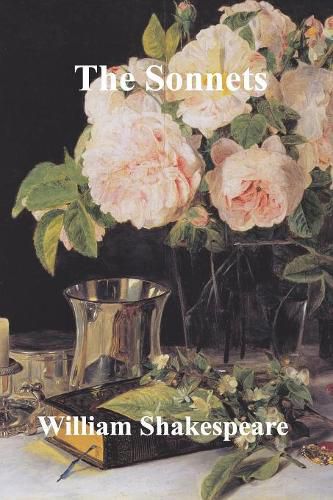Readings Newsletter
Become a Readings Member to make your shopping experience even easier.
Sign in or sign up for free!
You’re not far away from qualifying for FREE standard shipping within Australia
You’ve qualified for FREE standard shipping within Australia
The cart is loading…






This title is printed to order. This book may have been self-published. If so, we cannot guarantee the quality of the content. In the main most books will have gone through the editing process however some may not. We therefore suggest that you be aware of this before ordering this book. If in doubt check either the author or publisher’s details as we are unable to accept any returns unless they are faulty. Please contact us if you have any questions.
Shakespeare’s sonnets are poems that William Shakespeare wrote on a variety of themes. When discussing or referring to Shakespeare’s sonnets, it is almost always a reference to the 154 sonnets that were first published all together in a quarto in 1609; however there are six additional sonnets that Shakespeare wrote and included in the plays Romeo and Juliet, Henry V and Love’s Labour’s Lost. Shakespeare’s sonnets are considered a continuation of the sonnet tradition that swept through the Renaissance, from Petrarch in 14th-century Italy and was finally introduced in 16th-century England by Thomas Wyatt. With few exceptions, Shakespeare’s sonnets observe the stylistic form of the English sonnet - the rhyme scheme, the 14 lines, and the meter. But Shakespeare’s sonnets introduce such significant departures of content that they seem to be rebelling against well-worn 200-year-old traditions. Instead of expressing worshipful love for an almost goddess-like yet unobtainable female love-object, as Petrarch, Dante, and Philip Sidney had done, Shakespeare introduces a young man. He also introduces the Dark Lady, who is no goddess. Shakespeare’s sonnets are considered a continuation of the sonnet tradition that swept through the Renaissance, from Petrarch in 14th-century Italy and was finally introduced in 16th-century England by Thomas Wyatt. With few exceptions, Shakespeare’s sonnets observe the stylistic form of the English sonnet - the rhyme scheme, the 14 lines, and the meter. But Shakespeare’s sonnets introduce such significant departures of content that they seem to be rebelling against well-worn 200-year-old traditions. Instead of expressing worshipful love for an almost goddess-like yet unobtainable female love-object, as Petrarch, Dante, and Philip Sidney had done, Shakespeare introduces a young maexplores themes such as lust, homoeroticism, misogyny, infidelity, and acrimony in ways that may challenge, but which also open new terrain for the sonnet form.
$9.00 standard shipping within Australia
FREE standard shipping within Australia for orders over $100.00
Express & International shipping calculated at checkout
This title is printed to order. This book may have been self-published. If so, we cannot guarantee the quality of the content. In the main most books will have gone through the editing process however some may not. We therefore suggest that you be aware of this before ordering this book. If in doubt check either the author or publisher’s details as we are unable to accept any returns unless they are faulty. Please contact us if you have any questions.
Shakespeare’s sonnets are poems that William Shakespeare wrote on a variety of themes. When discussing or referring to Shakespeare’s sonnets, it is almost always a reference to the 154 sonnets that were first published all together in a quarto in 1609; however there are six additional sonnets that Shakespeare wrote and included in the plays Romeo and Juliet, Henry V and Love’s Labour’s Lost. Shakespeare’s sonnets are considered a continuation of the sonnet tradition that swept through the Renaissance, from Petrarch in 14th-century Italy and was finally introduced in 16th-century England by Thomas Wyatt. With few exceptions, Shakespeare’s sonnets observe the stylistic form of the English sonnet - the rhyme scheme, the 14 lines, and the meter. But Shakespeare’s sonnets introduce such significant departures of content that they seem to be rebelling against well-worn 200-year-old traditions. Instead of expressing worshipful love for an almost goddess-like yet unobtainable female love-object, as Petrarch, Dante, and Philip Sidney had done, Shakespeare introduces a young man. He also introduces the Dark Lady, who is no goddess. Shakespeare’s sonnets are considered a continuation of the sonnet tradition that swept through the Renaissance, from Petrarch in 14th-century Italy and was finally introduced in 16th-century England by Thomas Wyatt. With few exceptions, Shakespeare’s sonnets observe the stylistic form of the English sonnet - the rhyme scheme, the 14 lines, and the meter. But Shakespeare’s sonnets introduce such significant departures of content that they seem to be rebelling against well-worn 200-year-old traditions. Instead of expressing worshipful love for an almost goddess-like yet unobtainable female love-object, as Petrarch, Dante, and Philip Sidney had done, Shakespeare introduces a young maexplores themes such as lust, homoeroticism, misogyny, infidelity, and acrimony in ways that may challenge, but which also open new terrain for the sonnet form.